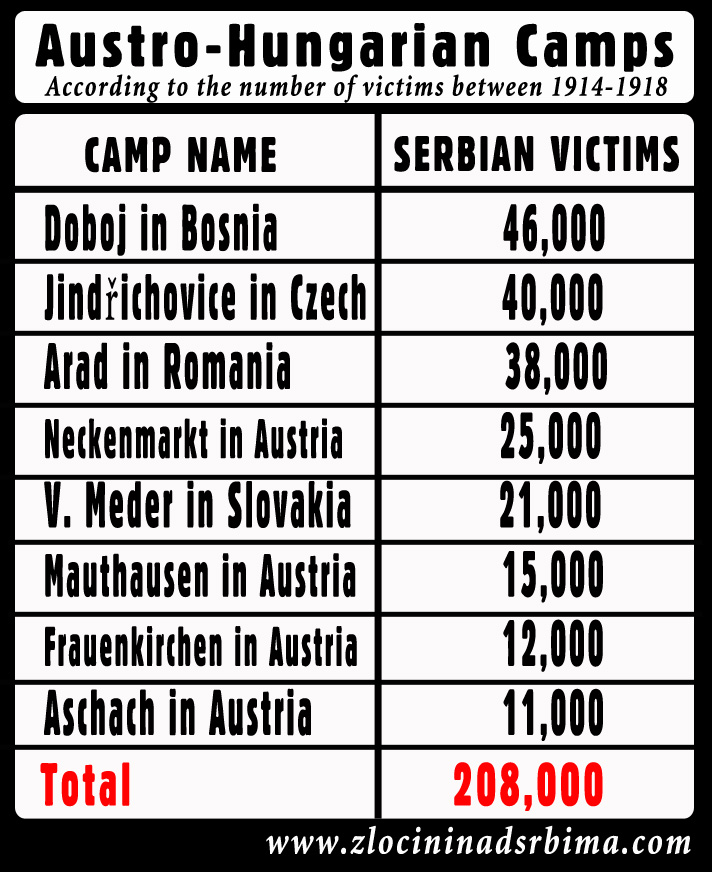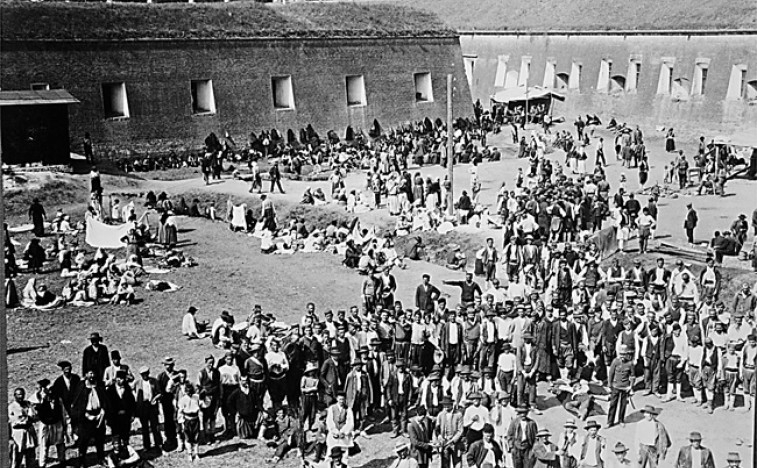Period:
First World War
Region:
Romania
Austro-Hungarian camp in Arad
 Camp Arad was a big concentration camp formed by the Austro-Hungarian Empire, for the imprisonment of Serbs and other Slavs, in the area of the north Banat region (today it is in the west part of Romania). Camp Arad was a big concentration camp formed by the Austro-Hungarian Empire, for the imprisonment of Serbs and other Slavs, in the area of the north Banat region (today it is in the west part of Romania).
The camp was established at the order of the Viennese Court in the summer of 1914 when Serb civilians were brought in from the territories of Dalmatia, Dubrovnik, Bosnia, Šumadija, Srem, Herzegovina and the Morava Valley. Arrests were carried out by the Schutzkorps (special militia whose members were mostly Bosnian Croatians and Muslims).
The camp was placed in the Fortress of Arad, which was constructed at the end of the 18th century. It is located 215 km away from Belgrade and 43 km away from Timisoara.
A couple of thousands of Serbs were imprisoned there. Roughly 20.000 prisoners were estimated to be detained (among them, brothers of Gavrilo Princip – Jovo and Nikola).
Civilians of both genders, all ages and financial status were transported to the camp.
Camp Arad is one of the most notorious Austro-Hungarian concentration camps established during World War I.
|
FIRST WORLD WAR 1914-1918 |
|
Battles of: Cer, Drina, Kolubara, Leget, Cemerno, Mojkovac, Kajmakcalan, Gornicevo, Dobro Polje
Camps: Mauthausen, Arad, Jindrihovice, Broumov, Boldogasonj, Nadjimer, Nezider, Aschah, Doboj, Sliven
Crimes: Macva, Surdulica, Great Retreat, Sabac
|
BACKGROUND
At the beginning of 1904, the Kingdom of Serbia signed a trade agreement with the USA, France and Russia... and began exporting its products to the overseas countries through the port of Thessaloniki.
This led to a great economic upswing of the Kingdom of Serbia, which annoyed the Vienna Court, which viewed Serbia as a great rival since Serbia had the highest economic growth rate in Europe at the time, and at the same time a large number of Serbs lived in the occupied territories of the Habsburg Monarchy.

Map of south-eastern Europe in November 1913.
The army of the Kingdom of Serbia liberated its enslaved territories (Raska, Kosovo and Metohija and Old Serbia) from the Turks in the First Balkan War, by achieving major victories in the fall of 1912 at the command of Duke Petar Bojovic at Kumanovo, Prilep and Bitola, and as such completely expelled the Ottomans from the Balkans.
And a year later in the summer of 1913 the army of the Kingdom of Serbia protected Vardar Macedonia from the Bulgarians in the Second Balkan War. The Serbian national revolution was thus continued, at the beginning of the 19th century by Karadjordje Petrovic and Milos Obrenovic.
In the summer of 1914, the Austro-Hungarian Monarchy used the Sarajevo assassination, that is, the assassination of Austrian Crown Prince Franz Ferdinand by members of Young Bosnia (Gavrilo Princip, Bogdan Zerajic, etc.) as an excuse to invade the Kingdom of Serbia, thus starting First World War.

Gavrilo Princip and his comrades in Sarajevo
A dispatch was sent from Vienna, which no sovereign state could accept. Thus, in late July 1914, Austria-Hungary declared war on Serbia. Montenegrin King Nikola I Petrovic and Russian Emperor Nikolai II Romanov immediately sent messages saying that they would help the Serbs. Likewise, German Emperor William II made a military alliance with the Vienna Palace.
History of Arad
Arad is situated in the northern Banat region, on the border with the Crisana region, on the right bank of the Mures river, today’s Romania. It’s located 100 meters above sea level, in the eastern part of the Pannonian Basin. Arad has a continental climate, warm summers and cold winters.
Serbs migrated to this region in the 15th century during the rule of the Ottoman Empire in the Balkans. The greatest migration occurred at the end of the 17th century and it was led by Patriarch Arsenije III Čarnojević. Arad was the last stop during Serb migrations. Around 100.000 Serbs came to Arad. Due to these migrations, Serbs were the majority of the population until the mid-18th century. They mostly engaged in trade, craftsmanship and art. There were also army officers among them, as well as patrons and publicists.

The greatest trace was left in Arad by a Serb noble and philanthropist Sava Tekelija (1761-1842), Doctor of Law (the first Serb to earn this degree) and a big Serb patriot and patron. He was a successful tradesman. He established a charitable foundation Tekelijanum in Budapest, where poor children could get their education, among them the most famous were: Nikola Tesla, Radivoje Kašanin, Isidor Popović... The most famous teachers were Laza Kostić and Jovan Jovanović Zmaj. Sava Tekelija was the first president of Matica Srpska (the oldest cultural-scientific institution of Serbia).
After the Treaty of Karlowitz was signed in 1699, Serbs found themselves under a great pressure from the Roman Catholic clergy to convert from Orthodox Christianity to Catholicism. A huge number of Serbs refused to accept the conversion and they continued to migrate towards Ukraine in the mid-1700s. One of their stops was Kiev, where two autonomous areas were established: Slaveno-Serbia (Slavo-Serbia) and Novoserbia (New Serbia).
.jpg) 
Famous artistic dynasties, such as Tenecki, Aleksić, Janić, Tabaković, originated from these areas.
ESTABLISHMENT OF THE CONCENTRATION CAMP
Establishment of the military fortification in Arad was directly ordered by the Empress Maria Theresa from 1763 to 1783 based on the plans of the Austrian architect Ferdinand Philipp von Harsch. The fortress had a form of a star with six corners and it was surrounded by the river Mures.
.jpg)
The Viennese Court had plans to establish concentration camps on its territory bordering Serbia even before war conflicts with Serbia started. The choice has fallen on Arad fortress, not far from Timisoara, where in July of 1914 the first civilian prisoners from Bosnia were brought.
New civilian prisoners from Mačva and Podrinje (Drina valley) were brought in August of 1914. Serbian army, at the order of the Allies, had to launch the Srem Offensive on September 6th, 1914. Serbian troops suffered a loss at Field Leget, near Sremska Mitrovica, and soldiers from the I Timok Infantry Division were brought to the camp afterwards.
CONDITIONS AT THE CONCENTRATION CAMP
The eyewitnesses and camp survivors testified that the concentration camp at Arad fortress was a living hell for the inmates, mostly Serbian civilians. Inmates lived in utterly inhumane conditions barely surviving in putrid moldy underground halls and rooms. There was barely enough lighting in very small rooms which housed too many prisoners.
Winters were very cold at that time and prisoners were freezing most of the time. Due to poor living conditions and starvation, there was an outbreak of various infectious diseases such as epidemic typhus and tuberculosis. More than a dozen people of all ages died each day.
The concentration camp at Arad fortress was a picture of great agony and suffering Serbs endured. Prisoners endured unimaginable maltreatment regardless of age. They were denied water, beaten to death, chained, women and children were often raped.
Dr. Branduša, a Romanian doctor, witnessed the situation at the camp and he wrote about what he saw to his dear friend, attorney at law Stefan Cicio Pop, deputy in the Hungarian Parliament:
- “Deputy, this is not a camp, this is hell! The first thing I saw and remembered was a dead mother holding a living baby in her arms. Words cannot describe this.”
Due to treatments described above, only in the first seven months, from August 1914 to March 1915, more than 1,700 inmates died. It is estimated that more than 5000 Serbs were killed in camp Arad during the war.
LIQUIDATION OF THE CAMP
This horrendous concentration camp was liquidated mid-November 1918, right after World War I ended, the dissolution of the Austro-Hungarian Empire (November 4th) and the capitulation of Germany (November 11th).

PUBLICATIONS
Ljubomir Stepanov is the author of the book “Arad fortress – concentration camp for Serb prisoners in World War I“, which was published by the Association of Serbs in Romania in the end of 2014 to commemorate the 100th anniversary of the Great War.
Radio Television of Serbia made two documentaries about the concentration camp Arad. The author of the first documentary is Branko Stanković, also the author of the show “Kvadratura kruga”. The author of the second documentary is Ljubisav Aleksić and it was shown in the TV show “Trag“.
Writer Slaviša Radovanović from Požarevac wrote a novel “Serbian matchbox – does Arad exist?”. The plot is situated in the concentration camp Arad during the Great War and the main characters are two Serbs, one is the prisoner of the camp and the other one is the guard.
THE AFTERMATH
Soldiers of the Red Army (Army of the Soviet Union) occupied the fortress after the Second World War and destroyed traces of encampment of Serbs. They left the fortress in 1991.
The Ministry of Culture of the Republic of Serbia started an initiative back in 2013 to erect a memorial in Arad.
The only memorial existing in Arad today is a monument commemorating Arad guards (a few Serbs also served as the camp guards) which died of typhus, alongside many prisoners.
Tags:
|
|
AUSTRO HUNGARIAN MONARCHY
|
|
|
|
|
|
|
|
|
| | | | | | | |
Please, vote for this article:
Visited: 4520 point
Number of votes: 6
|